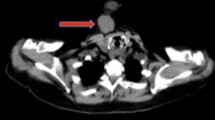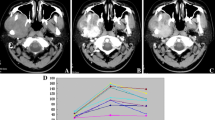Abstract
The objective of this study is to analyze the outcome of treatment for solitary fibrous tumors (SFTs) in the head and neck area. SFTs present as slow-growing masses, often with local compressive symptoms that are difficult to distinguish from other soft-tissue tumors. SFTs are commonly treated using local excision without adjuvant therapy. To date, only heterogeneous small series have been published, documenting the treatment results and outcome with these tumors. Retrospective study of patients with histopathologically confirmed SFT treated at two tertiary referral hospitals between 2004 and 2014. Eight men and four women with histologically confirmed SFT were identified in the records. Their age range was 37–82 years (mean 57.8 years). The mean follow-up period for eight patients was 6.75 years (range 1–24 years). Four patients were lost to follow-up. Sublocalizations were neck (n = 3), orbit (n = 2), paranasal sinus (n = 2), cheek (n = 2), hard palate (n = 1), parotid gland (n = 1), and tongue (n = 1). The first-line treatment for all of the tumors identified was surgical excision. In four cases, the surgical margins were narrow or unclear due to piecemeal resection in the paranasal sinus and orbit (n = 3) or a tumor location deep in the parapharyngeal space (n = 1). Recurrences developed in two of these cases (in the orbit and parapharyngeal space), and the other two patients were lost to follow-up. Radiotherapy and chemotherapy were not administered as first-line treatments. Overall, the local recurrence rate (n = 2/8) was 25 %. The disease-specific survival rate was 100 %. These results are consistent with the literature data and show that safe surgical excision, without opening of the tumor capsule, reduces the risk of local recurrence and leads to a favorable outcome. Tumors in the head and neck often represent a surgical challenge, and wide surgical margins are rarely possible due to the complex three-dimensional anatomic compartments in the region. Head and neck surgeons should therefore be aware that there is an increased risk of recurrence in these patients; tightly scheduled follow-up visits are mandatory for at least 10 years, if not longer. Radiotherapy only appears to be an option in patients with unresectable tumors or when wide surgical excision would cause severe functional morbidity.







Similar content being viewed by others
References
Klemperer P, Rabin CB (1931) Primary neoplasms of the pleura: a report of 5 cases. Arch Pathol 11:385–412
Bilbey JH, Müller NL, Miller RR, Nelems B (1988) Localized fibrous mesothelioma of pleura following external ionizing radiation therapy. Chest 94:1291–1292
Clagett OT, McDonald JR, Schmidt HW (1952) Localized fibrous mesothelioma of the pleura. J Thorac Surg 24:213–230
Cobanoglu A, Reinhard JJ Jr (1982) Localized fibrous mesothelioma of the pleura: two case reports. Del Med J 54:273–276
Dervan PA, Tobin B, O’Connor M (1986) Solitary (localized) fibrous mesothelioma: evidence against mesothelial cell origin. Histopathology 10:867–875
Doucet J, Dardick I, Srigley JR, van Nostrand AW, Bell MA, Kahn HJ (1986) Localized fibrous tumour of serosal surfaces. Immunohistochemical and ultrastructural evidence for a type of mesothelioma. Virchows Arch A Pathol Anat Histopathol 409:349–363
Katz S (1955) Localized fibrous mesothelioma of the pleura. GP 12:119
Kim H, Damjanov I (1983) Localized fibrous mesothelioma of the liver. Report of a giant tumor studied by light and electron microscopy. Cancer 52:1662–1665
Nathan H, Seiden D (1978) Localized fibrous mesothelioma of the pleura. Int Surg 63:161–165
Said JW, Nash G, Banks-Schlegel S, Sassoon AF, Shintaku IP (1984) Localized fibrous mesothelioma: an immunohistochemical and electron microscopic study. Hum Pathol 15:440–443
Scharifker D, Kaneko M (1979) Localized fibrous “mesothelioma” of pleura (submesothelial fibroma): a clinicopathologic study of 18 cases. Cancer 43:627–635
Stout AP (1950) Solitary fibrous mesothelioma of the peritoneum. Cancer 3:820–825
Stout AP, Himadi GM (1951) Solitary (localized) mesothelioma of the pleura. Ann Surg 133:50–64
Weilbaecher TG, Sarma DP (1984) Localized fibrous mesothelioma of the pleura. J Surg Oncol 25:67–70
Gengler C, Guillou L (2006) Solitary fibrous tumour and haemangiopericytoma: evolution of a concept. Histopathology 48:63–74
Witkin GB, Rosai J (1991) Solitary fibrous tumor of the upper respiratory tract. A report of six cases. Am J Surg Pathol 15:842–848
Alawi F, Stratton D, Freedman PD (2001) Solitary fibrous tumor of the oral soft tissues: a clinicopathologic and immunohistochemical study of 16 cases. Am J Surg Pathol 25:900–910
Dorfman DM, To K, Dickersin GR, Rosenberg AE, Pilch BZ (1994) Solitary fibrous tumor of the orbit. Am J Surg Pathol 18:281–287
Zukerberg LR, Rosenberg AE, Randolph G, Pilch BZ, Goodman ML (1991) Solitary fibrous tumor of the nasal cavity and paranasal sinuses. Am J Surg Pathol 15:126–130
Kohmura T, Nakashima T, Hasegawa Y, Matsuura H (1999) Solitary fibrous tumor of the paranasal sinuses. Eur Arch Otorhinolaryngol 256:233–236
Pasquini E, Cantaroni C, Salfi N, Tamburini G, Marchi C, Sciarretta V (2003) Endoscopic treatment of an ethmoidal solitary fibrous tumour. J Laryngol Otol 117:889–891
Jeong AK, Lee HK, Kim SY, Cho KJ (2002) Solitary fibrous tumor of the parapharyngeal space: MR imaging findings. AJNR Am J Neuroradiol 23:473–475
Benlyazid A, Lescanne E, Lefrancq T, Fetissoff F, Beutter P (1998) Solitary fibrous tumor of the larynx: report of a case. J Laryngol Otol 112:286–289
Ferreiro JA, Nascimento AG (1996) Solitary fibrous tumor of the major salivary glands. Histopathology 28:261–264
Kie JH, Kim JY, Park YN, Lee MK, Yang WI, Park JS (1997) Solitary fibrous tumor of the thyroid. Histopathology 30:365–412
Ito H, Fukuda M, Imamura Y, Fuse H (2008) A malignant solitary fibrous tumor in the retroperitoneum. Int J Clin Oncol 13:173–175
Cox DP, Daniels T, Jordan RC (2010) Solitary fibrous tumor of the head and neck. Oral Surg Oral Med Oral Pathol Oral Radiol Endod 110:79–84
Schürch W, Skalli O, Lagacé R, Seemayer TA, Gabbiani G (1990) Intermediate filament proteins and actin isoforms as markers for soft-tissue tumor differentiation and origin. III. Hemangiopericytomas and glomus tumors. Am J Pathol 136:771–786
Agaimy A, Barthelmess S, Geddert H, Boltze C, Moskalev EA, Koch M, Wiemann S, Hartmann A, Haller F (2014) Phenotypic and molecular distinctness of sinonasal haemangiopericytoma compared to solitary fibrous tumour of the sinonasal tract. Histopathology 65:667–673
Fletcher CDM, Bridge JA, Lee JC (2013) Extrapleural solitary fibrous tumour. In: Fletcher CDM, Bridge JA, Hogendoorn PCW, Mertens F (eds) WHO classification of tumours of soft tissue and bone, 4th edn. IARC Press, Lyon, pp 80–82
Guillou L, Fletcher JA, Fletcher CDM, Mandahl N (2002) Extrapleural solitary fibrous tumor and hemangiopericytoma. In: Fletcher CDM, Unni KK, Mertens F (eds) Pathology and genetics of tumours of soft tissue and bone. IARC Press, Lyon, pp 86–90
Furusato E, Valenzuela IA, Fanburg-Smith JC, Auerbach A, Furusato B, Cameron JD, Rushing EJ (2011) Orbital solitary fibrous tumor: encompassing terminology for hemangiopericytoma, giant cell angiofibroma, and fibrous histiocytoma of the orbit: reappraisal of 41 cases. Hum Pathol 42:120–128
Schulz B, Altendorf-Hofmann A, Kirchner T, Katenkamp D, Petersen I, Knösel T (2014) Loss of CD34 and high IGF2 are associated with malignant transformation in solitary fibrous tumors. Pathol Res Pract 210:92–97
Knösel T, Schulz B, Katenkamp K, Katenkamp D, Petersen I (2010) Solitary fibrous tumor and haemangiopericytoma: what is new? Pathologe 31:123–128 (German)
Ide F, Obara K, Mishima K, Saito I, Kusama K (2005) Ultrastructural spectrum of solitary fibrous tumor: a unique perivascular tumor with alternative lines of differentiation. Virchows Arch 446:646–652
Barnes L, Eveson JW, Reichart P, Sidransky D (eds) (2005) World Health Organization classification of tumours. Pathology and genetics of head and neck tumours. IARC Press, Lyon
Chan JKC (1997) Solitary fibrous tumour—everywhere, and a diagnosis in vogue. Histopathology 31:568–576
Gold JS, Antonescu CR, Hajdu C, Ferrone CR, Hussain M, Lewis JJ, Brennan MF, Coit DG (2002) Clinicopathologic correlates of solitary fibrous tumors. Cancer 94:1057–1068
Alawi F, Stratton D, Freedman PD (2001) Solitary fibrous tumor of the oral soft tissues: a clinicopathologic and immunohistochemical study of 16 cases. Am J Surg Pathol 25:900–910
Mentzel T, Bainbridge TC, Katenkamp D (1997) Solitary fibrous tumour: clinicopathological, immunohistochemical, and ultrastructural analysis of 12 cases arising in soft tissues, nasal cavity and nasopharynx, urinary bladder and prostate. Virchows Arch 430:445–453
Wushou A, Miao XC, Shao ZM (2014) Treatment outcome and prognostic factors of head and neck hemangiopericytoma A meta-analysis. Head Neck. doi:10.1002/hed.23812 (Epub ahead of print)
Fukunaga M, Naganuma H, Nikaido T, Harada T, Ushigome S (1997) Extrapleural solitary fibrous tumor: a report of seven cases. Mod Pathol 10:443–450
Briselli M, Mark EJ, Dickersin GR (1981) Solitary fibrous tumors of the pleura: eight new cases and review of 360 cases in the literature. Cancer 47:2678–2689
Brunnemann RB, Ro JY, Ordonez NG, Mooney J, El-Naggar AK, Ayala AG (1999) Extrapleural solitary fibrous tumor: a clinicopathologic study of 24 cases. Mod Pathol 12:1034–1042
Vallat-Decouvelaere AV, Dry SN, Fletcher CD (1998) Atypical and malignant solitary fibrous tumors in extrathoracic locations: evidence of their comparability to intra-thoracic tumors. Am J Surg Pathol 22:1501–1511
England DM, Hochholzer L, McCarthy MJ (1989) Localized benign and malignant fibrous tumors of the pleura. A clinicopathologic review of 223 cases. Am J Surg Pathol 13:640–658
Meyer M, Krause U (1999) Solitary fibrous tumors of the pleura. Chirurg 70:949–952 (German)
Ginat DT, Bokhari A, Bhatt S, Dogra V (2011) Imaging features of solitary fibrous tumors. AJR Am J Roentgenol 196:487–495
Liu Y, Tao X, Shi H, Li K (2014) MRI findings of solitary fibrous tumours in the head and neck region. Dentomaxillofac Radiol 43:20130415. doi:10.1259/dmfr.20130415 (Epub 2014 Feb 3)
Ganly I, Patel SG, Stambuk HE, Coleman M, Ghossein R, Carlson D, Edgar M, Shah JP (2006) Solitary fibrous tumors of the head and neck: a clinicopathologic and radiologic review. Arch Otolaryngol Head Neck Surg 132:517–525
Conflict of interest
The authors hereby state that there are no conflicts of interest and nothing to declare.
Author information
Authors and Affiliations
Corresponding author
Rights and permissions
About this article
Cite this article
Künzel, J., Hainz, M., Ziebart, T. et al. Head and neck solitary fibrous tumors: a rare and challenging entity. Eur Arch Otorhinolaryngol 273, 1589–1598 (2016). https://doi.org/10.1007/s00405-015-3670-1
Received:
Accepted:
Published:
Issue Date:
DOI: https://doi.org/10.1007/s00405-015-3670-1




